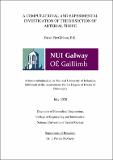| dc.description.abstract | The overall objective of this thesis is to provide a new understanding of the mechanisms underlying arterial fracture, and to extend this understanding to the initiation and propagation of aortic dissection using a combination of experimental testing and computational modelling.
Aortic dissection is a lethal disease that involves the separation of the arterial layers and carries mortality rates as high as 1-2% per hour untreated. However, to date the exact pathophysiological processes and related biomechanisms underlying aortic dissection have not been uncovered. We present the development and implementation of a novel experimental technique to generate and characterise mode II crack initiation and propagation in arterial tissue. We begin with a demonstration that lap-shear testing of arterial tissue results in mixed mode fracture, rather than mode II. A detailed computational design of a novel experimental method (shear fracture ring test (SFRT)) to robustly and repeatably generate mode II crack initiation and propagation in arteries is presented. This method is based on generating a localised region of high shear adjacent to a cylindrical loading bar. Placement of a radial notch in this region of high shear stress is predicted to result in a kinking of the crack during a mode II initiation and propagation of the crack over a long distance in the circumferential (c)-direction along the circumferential-axial (c-a) plane. Fabrication and experimental implementation of the SFRT on excised ovine aorta specimens confirms that the novel test method results in pure mode II initiation and propagation. We demonstrate that the mode II fracture strength along the c-a plane is eight times higher than the corresponding mode I strength determined from a standard peel test. We also calibrate the mode II fracture energy based on our measurement of crack propagation rates. The mechanisms of fracture uncovered, along with the quantification of mode II fracture properties have significant implications for current understanding of the biomechanical conditions underlying aortic dissection.
We observe that a standard exponential-CZM (E-CZM) is unable to capture the key trends associated with a collagenous interface undergoing fibrillation, namely, the non-linear crack growth observed during SFRT experiments. We propose an elastic fibrillation CZM (EF-CZM) and explore its conformability to the experimental data. An incremental improvement is obtained relative to the E-CZM; however, crack growth slows prematurely. It is found that the final regime of crack growth is insensitive to the model parameters. The EF-CZM fails to capture the key mechanisms underlying the fibrillation fracture process. It is hypothesised that the dissipative process of fibre pull-out may be an important consideration in phenomenologically capturing the experimental trends. Furthermore, we theorize that crack growth velocity and fibrillation may be related, and thus, a rate dependence may be necessary to phenomenologically capture the physics of the fibrillation process. Therefore, a viscoplastic CZM is developed, where the rate of strain hardening is dependent on the applied strain rate. We present a full exploration of the viscoplastic CZM and demonstrate a thermodynamic consideration of the CZM which demonstrates positive
iii
instantaneous incremental dissipation of the elastic and plastic components of the CZM throughout all loading scenarios considered in the present study. Finally we explore the conformability of viscoplastic CZM to the fracture experiments of FitzGibbon and McGarry (2020) and demonstrate that the introduction of a rate-dependent plasticity captures the key trends observed experimentally, namely, the slow crack growth regime proceeded by fast crack growth and again by slow crack growth.
A realistic subject-specific aorta finite element model derived from a dual-venc MRI scan is developed. We investigate if spontaneous dissection will occur under extreme hypertensive lumen blood pressure loading, or if significant reduction in interface strength must occur in order for dissection to initiate. Importantly, it is also demonstrated that dissection initiation is a pure mode II fracture process, rather than a mixed mode or mode I process. We construct a parameterised idealised aorta model in order to assess the relative contribution for several anatomical and physiological factors to dissection risk. Such parametric analyses provide fundamental insight into the mechanics of stress localisation and delamination in the aorta. Overall, the detailed series of simulations suggest that variations in anatomical features and hypertensive loading will not result in a sufficient elevation of the stress state in the aorta wall to initiate dissection. Our results suggest that initiation of aortic dissection requires a significant reduction in the mode II fracture strength of the aortic wall, suggesting that dissection is preceded by structural and biomechanical remodelling.
Finally, we examine the risk of dissection in an artery with a range of pre-existing injuries. The risk of dissection is examined in an artery with an intimal tear (radial notch). Finite element cohesive zone analyses suggest propagation of an intimal tear is not predicted for pressures less than P=275 mmHg in a healthy aorta. The risk of dissection is then examined in an artery with a pre-existing intraluminal septum and a patent false lumen. Computational fluid dynamics (CFD) analyses are performed, and pressure data is extracted and applied to a solid fracture model. The results of the combined fluid dynamics and finite element cohesive zone analyses suggest extensive propagation of a false lumen is not predicted at a slightly hypertensive systolic pressure of 140 mmHg in a healthy aorta. Even in extreme hypertensive loading conditions AD propagation is arrested due to blunting of the crack tip and an increase in the mode angle towards mode II. The results of this study suggest an intimal tear will not develop into a false lumen in a healthy normotensive aorta. | en_IE |


